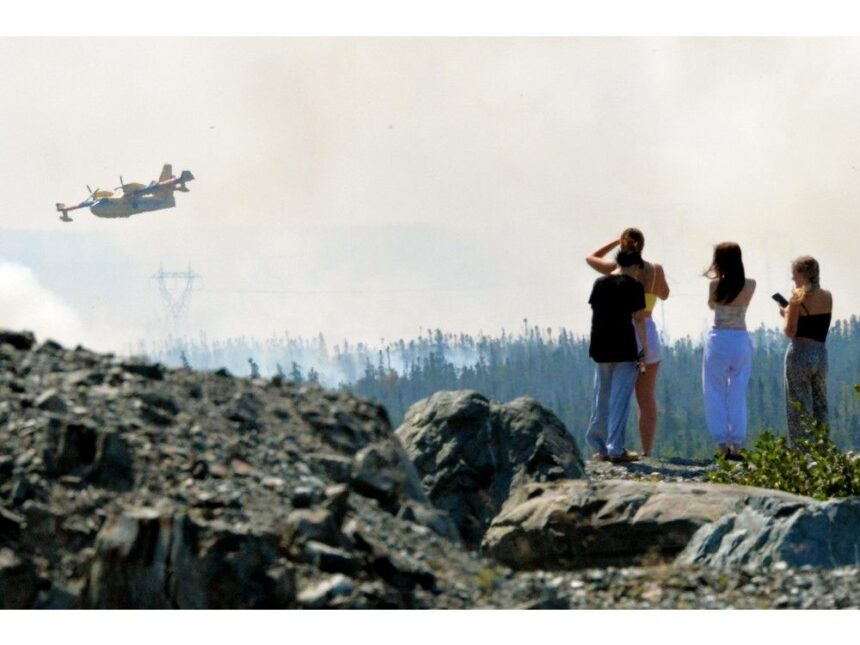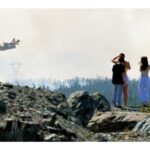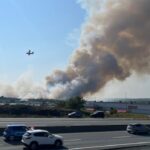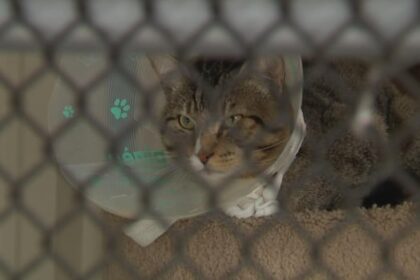Experts and officials weigh in on best practices, incoming weather, airport impacts, pet care and morePublished Aug 12, 2025Last updated 3 hours ago8 minute readAt mid-day Tuesday August 12, 2025, at least three waterbombers, a birddog airplane and a helicopter were fighting the Paddy’s Pond wildfire near St. John’s, Mount Pearl and Paradise. Here, onlookers stand on a nearby hill watching the efforts. Photo by Keith Gosse/The Telegram /Keith Gosse/The TelegramArticle contentAs multiple wildfires continue to threaten communities across Newfoundland and Labrador, it’s only natural for local residents to be curious and ask questions in the name of safety and preparedness amid this nerve-wracking summer fire outbreak. THIS CONTENT IS RESERVED FOR SUBSCRIBERS ONLY.Subscribe now to access this story and more:Unlimited access to the website and appExclusive access to premium content, newsletters and podcastsFull access to the e-Edition app, an electronic replica of the print edition that you can share, download and comment onEnjoy insights and behind-the-scenes analysis from our award-winning journalistsSupport local journalists and the next generation of journalistsSUBSCRIBE TO UNLOCK MORE ARTICLES.Subscribe or sign in to your account to continue your reading experience.Unlimited access to the website and appExclusive access to premium content, newsletters and podcastsFull access to the e-Edition app, an electronic replica of the print edition that you can share, download and comment onEnjoy insights and behind-the-scenes analysis from our award-winning journalistsSupport local journalists and the next generation of journalistsRegister to unlock more articles.Create an account or sign in to continue your reading experience.Access additional stories every monthShare your thoughts and join the conversation in our commenting communityGet email updates from your favourite authorsSign In or Create an AccountorArticle contentOn Tuesday morning, The Telegram scoured the Internet to compile a list of the most frequently asked questions in hopes of quashing potential misinformation that may creep into social media feeds as concerned residents clamour to locate quick and reliable information.Article contentArticle contentArticle contentThe Telegram contacted city officials, meteorologists, veterinarians and other experts to help answer these common questions in the name of helping the public stay safe and informed with this ongoing situation. Article contentHow can I help?Article content While city spokesperson Jackie O’Brien says there’s no shortage of residents looking for ways to help out with the ongoing wildfires, no additional volunteers or supplies are required at this time. Photo by Keith Gosse/THE TELEGRAM file photoArticle contentWith the recent Paddy’s Pond fire popping up inside city limits, Jackie O’Brien, spokesperson for the City of St. John’s, says city hall has received multiple inquiries from kind-hearted residents asking how they may be able to help with firefighting efforts or how to best support those engaged in the fight against the flames. Article contentWhile the city is appreciative of those willing to lend a hand, O’Brien says volunteers and additional supplies are not required at this time.Article content“Some people want to know how they can help,” O’Brien told The Telegram.Article content“Right now, we’ll let you know if we need you. It’s all in good faith, but we can’t just start taking Gatorades without somewhere to put it, kind of thing.”Article contentArticle contentShould additional support, supplies or volunteers be needed, O’Brien says those efforts will be coordinated through partnering agencies, including the Canadian Red Cross and the Salvation Army. Article contentArticle content“The best thing people could do right now is to continue to follow official information and respect the alerts. If there is an opportunity (to provide additional support), most of those efforts are coordinated through the Red Cross and the Salvation Army.”Article contentFor further information on how the wildfires may potentially impact residents in St. John’s, O’Brien recommends visiting the City of St. John’s ‘Emergency Alerts’ page on the municipality’s website. Article contentIs there anything in the immediate forecast that might provide some relief?Article content Meteorologist Eddie Sheerr says there may be some rain on the way later in the week, but fears it may not be enough to put much of a dent in the province’s wildfires. CONTRIBUTEDArticle contentMeteorologist Eddie Sheerr says there’s a possibility of rain for parts of Eastern Newfoundland later in the week but it may not be enough precipitation to have a measurable impact on the fires. Article content“There’s a chance of rain for what looks like Thursday into Friday for eastern Newfoundland,” Sheerr told The Telegram. “Right now, it does not look like it would be significant, but it’s something.” Article contentWhile the rain may not provide much immediate relief, Sheerr says the incoming humidity may be more helpful than you might think.Article content“After today, we should notice more humidity in the air,” Sheerr explains.Article content“Once you bring the humidity up, the fires don’t burn nearly as effectively and efficiently. We will still see growth from these fires, but my hope is that as the humidity increases, hopefully it’s slower and less than what we saw yesterday and what we might see again here today.” Article contentWhat weather conditions would be ideal to help suppress these fires?Article content If you know how to perform a rain dance, it might be time to bust out your dancing shoes. Rain, drizzle and fog have historically been unwelcome in Newfoundland and Labrador in the summertime, but would be a perfect combination to help turn the tide on the province’s wildfires. Photo by Andrew Waterman /Andrew WatermanArticle contentFor those individuals keen on scouring long-term weather reports in search of potential incoming relief from Mother Nature, Sheerr says to keep an eye on wind strength and direction, temperatures, humidity and precipitation.Article contentArticle content“When it comes to fires, fires like three things: they like heat, dry air and wind,” he said.Article content“With the situation we have here now, we’re basically getting, for lack of a better term, ideal fire growth conditions day in and day out. Article content“The best case would be rain, drizzle or fog, a complete switch in the wind directions with onshore northerly or easterly winds, moisture in the air and heavy rain. That would be the best-case scenario. That would help put the fire out and stop it from growing kind of at the same time.” Article contentIt’s still very warm outside, should I not run my air conditioning unit because of the smoke?Article content You may want to confirm with your installer or manufacturer to ensure your air conditioning unit is safe to use in smoky conditions. Photo by SaltWire Network /SaltWire NetworkArticle contentWhile he’s no HVAC professional, Sheerr suggests, in general terms, that any unit that pulls in air from outside your home should be turned off, but says most mini-splits and heat pumps may be safe to use, provided they do not take in smoky air from outside your home. Article contentArticle content“If you’re in an area where there’s smoke and you can see it or you can smell it, turn off your air exchanger,” Sheerr said.Article content“I would speak to your HVAC company to be sure, but from the research I’ve done, mini-splits generally don’t pull in outside air. They recirculate the air that’s inside. They should be ok to leave on, but some do pull in outside air, so that’s a bit of a generalized statement. Article content“Air exchangers definitely should be shut off when there’s smoke around because they do pull in outside air.” Article contentShould I not have my windows open or put clothes on the clothesline?Article content You may want to check on your local air quality reports before hanging your clothes outdoors to dry. Photo by Contributed /ContributedArticle contentAir quality is a tricky beast to predict when it comes to wildfires as the air quality can change quickly as a result of drifting winds, the location of the fire, the material that’s burning and a number of other factors.Article contentAs a general rule of thumb, Sheerr recommends verifying the air quality through a reputable, verified source before making an informed decision to prop open that window or throwing the laundry on the line.Article content“It depends on the air where you are,” Sheerr said.Article content“I’m here in the east end and I went for a run this morning and I didn’t see a lick of smoke. It can be fairly localized, so use your best judgment. If you smell it, it’s there. If you don’t smell it, it’s probably not impacting air quality too much, in my opinion.” Article contentWill these fires and this smoke have any impact on flights coming in and out of St. John’s International Airport?Article content The St. John’s International Airport Authority will be keeping a close eye on changing conditions, but regional wildfires haven’t yet caused any major disruptions or delays. Photo by SaltWire Network /SaltWire NetworkArticle contentWhile there’s no way of knowing for sure if any future flights will be impacted by the unpredictable nature of wildfires, a statement received from the St. John’s International Airport Authority suggests it’s business as usual for most incoming and outgoing travellers, but airport officials will be monitoring the situation closely for any changes.Article content“Flights in and out of YYT are operating as scheduled and we are closely monitoring wildfire activity in the region,” the statement said.Article contentArticle content“NAV CANADA manages the airspace and may adjust some procedures to accommodate firefighting operations. If you are travelling, please continue to monitor your airline for any alerts. Any changes to operations at YYT will be shared as required.” Article contentHow will the smoke impact my pets? Are there any signs of distress I should look for?Article content Veterinarian Dr. Maggie Brown-Bury says that some pets, including elderly pets, asthmatic cats and flat-faced dogs, should be treated as ‘high risk’ individuals and shared some tips on what to look for to ensure your pet is safe and sound amidst smoky conditions.Article contentAccording to small animal veterinarian Maggie Brown-Bury, wildfire smoke and poor air quality has the potential to impact our pets in a similar way it impacts us as humans.Article contentThe same as how some humans are considered ‘high-risk’ as a result of pre-existing health conditions, certain animals are similarly at risk and may require extra attention to make sure they’re happy and healthy during the wildfires.Article content“For elderly pets or any animal that has any concerns with breathing to begin with, they are going to be more sensitive,” Brown-Bury said. Article contentArticle content“There’s also a concern that some cats can have allergic bronchitis or asthma, and similar to people with asthma, a change in air quality can cause that to get much worse. As well, flat-faced dogs who generally have difficulty with breathing, we definitely want to treat them as at-risk individuals.”Article contentBrown-Bury says to keep an ear open in case your pet starts coughing more than usual or if their breathing becomes heavy or raspy and to contact their local veterinarian to seek appropriate treatment to avoid symptoms becoming worse. Article contentShould I not let my pet outside?Article content It’s only natural for a dog to need to go outside to take care of its business, but Dr. Brown-Bury says it’s critical to limit the amount of time your pet spends outside when air quality is poor. Photo by Contributed /ContributedArticle contentMany animals, dogs in particular, require frequent outdoor time for exercise and to take care of business when nature calls. Article contentBrown-Bury says it’s not practical to keep these pets indoors for these activities and recommends limiting time spent outside to the bare minimum.Article content“Outside trips are going to be shorter,” Brown-Bury said of how she will handle the situation with her own energetic young pup.Article content“We’re not going to be going for a run but instead going for a slow walk. What we don’t want is for them to be panting and breathing heavily and taking in a lot of air because that will make the situation worse for them.” Article contentLike Sheerr, Brown-Bury recommends keeping a close eye on reputable air quality reports and make an effort to let your pets outside during periods when air quality reports are low.Article content“There are certain times of the day when the air quality is going to be better or worse,” she said. Article content“Try to take advantage of the periods where it is better. I know there’s been lots of posts about not having your air exchanger on and having your windows closed when the air quality is bad to protect the inside of your home and maybe some people are not taking that as seriously as they should. Article contentArticle content“If you have an elderly pet or a pet with health conditions, particularly a cat with asthma, you really should be taking those kinds of suggestions seriously.” Article contentHow can I protect outdoor animals like livestock in these hot and smoky conditions?Article content While larger barnyard animals, like horses and cows, may be more naturally resilient to wildfire smoke, keepers should still try to find a way to keep these animals inside to avoid exposure to smoke.Article contentFor those in the region who are keepers of livestock and other outdoor animals, Brown-Bury, upon consultation with colleagues who specialize in the care of larger animals, confirmed that larger animals like horses and cows tend to be more resilient than smaller animals, but should still be moved inside and kept cool if at all possible. Article content“Most large animal recommendations are to keep them well hydrated and supplemented with electrolytes,” she said. “We suggest to keep them inside with fans on during the day. Cool towels also help.”Article contentAn equine veterinary colleague also confirmed with Brown-Bury that wildfire smoke is harmful for all organisms with lungs, human or otherwise, and reducing exposure to smoky air should always be the first step. Article contentArticle contentBrown-Bury also shared that barns and other large animal shelters may become extremely flammable if dry conditions persist, and stressed the importance of preparedness and early evacuation for all animals, big and small.Article content“One thing that I have seen is people being unprepared for an evacuation situation,” she said.Article content“I’ve seen a lot of people on Facebook asking if people have an extra cat carrier, for example. People don’t always have the means to safely evacuate their pets, so don’t wait until you’re in an evacuation alert area to start thinking about it.”Article contentBrown-Bury recommends making a list of essential items, including food, water and medications, and to consider picking up those essential items sooner rather than later to avoid potential complications in the event of an evacuation.Article content“What I’m seeing is a lot of people starting to panic and stress and that’s when you forget things or make poor decisions,” she said.Article content“People think about their own medications but you have to think about your pet’s medications as well as their food and water. You might not have a chance to quickly grab a bag of food if you get evacuated. Just think about everything you need for your pet for at least a week if it should come to that.”Article content
Wildfire FAQ: Everything you need to know to stay safe amidst smoky, hot conditions











